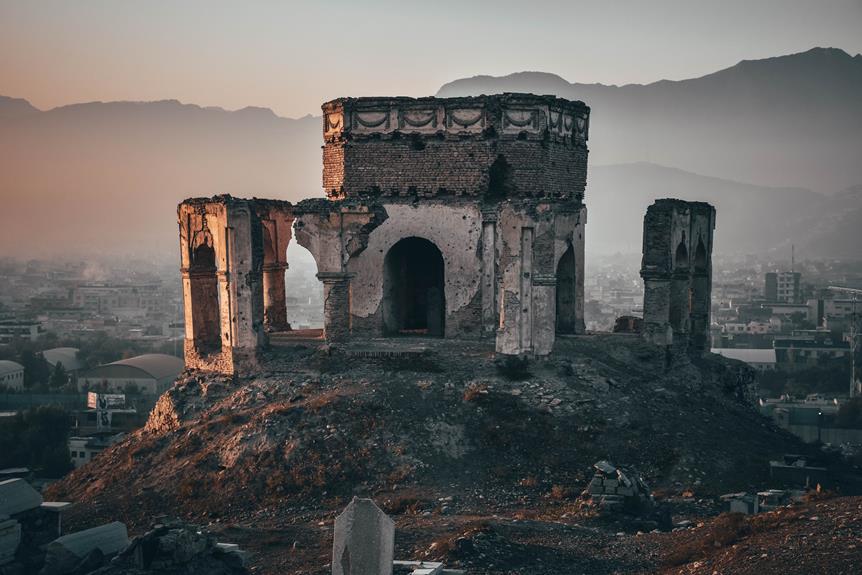Step into the mystical past of Algarve and discover the enigmatic ancient ruins that lie hidden beneath its serene landscape. These remnants of a bygone era hold secrets waiting to be unearthed, offering a captivating journey through Portugal's rich history.
From the majestic Castelo de Silves, standing tall since 994, to the well-preserved Roman ruins of Milreu, each site reveals a chapter of this land's fascinating story. Immerse yourself in the outdoor ruins and history museum of Cerro da Vila or wander the cobbled streets surrounding the imposing Município de Silves.
For a truly immersive experience, the Nucleo Museologico da Villa Romana de Milreu offers a glimpse into the past through its well-preserved ruins and indoor museum. Algarve's ancient ruins are a treasure trove waiting to be explored, allowing you to serve your thirst for knowledge and uncover Portugal's mesmerizing past.
Key Takeaways
- Algarve is home to a variety of ancient ruins, including Roman ruins, megalithic sites, Phoenician and Carthaginian remains, and Visigothic and medieval structures.
- The region's Roman ruins, such as Castelo de Silves and the Roman Ruins of Milreu, showcase detailed architecture and well-preserved tile mosaics, reflecting the rich history and cultural heritage of the area.
- Algarve exhibits a blend of Roman and Moorish influences, with Moorish architectural elements found in Castelo de Silves and a blending of styles in the Roman Ruins of Milreu, highlighting the cultural diversity and influences throughout history.
- The presence of megalithic sites like Cromeleque dos Almendres and Anta Grande do Zambujeiro, as well as Phoenician and Carthaginian remains, such as the Temple of Diana and Carthaginian settlement remains in Silves, provide insights into the ancient civilizations that once thrived in Algarve.
Roman Ruins in Algarve
I absolutely love exploring the Roman ruins in Algarve. These ancient ruins are a testament to the rich history and cultural heritage of the region. One of the most remarkable sites is the Roman Ruins of Milreu. Designated as a UNESCO World Heritage site, Milreu boasts well-preserved ruins that showcase the grandeur and opulence of Roman villas. Walking through the ruins, I'm in awe of the intricate tile mosaics and the detailed architecture that have withstood the test of time.
Another must-visit site is the Castelo de Silves, an imposing castle built in 994. The castle offers a panoramic view of the surrounding area and provides a glimpse into the strategic importance of Algarve in medieval times. As I explore these ancient ruins, I can't help but marvel at the history and significance they hold.
Transitioning into the subsequent section about Moorish influences in Algarve, it's fascinating to see how different cultures have left their mark on this enchanting region.
Moorish Influences in Algarve
The presence of Moorish influences in Algarve's ancient ruins is undeniable, as evidenced by the architectural styles showcased in sites such as Castelo de Silves and the Roman Ruins of Milreu. These ruins not only reflect the region's Roman past, but also highlight the influence of Moorish culture during the Middle Ages.
At Castelo de Silves, for example, the Moorish architectural elements are apparent in the fortress walls, which were constructed using a technique known as taipa, a mixture of mud and straw. Similarly, the Roman Ruins of Milreu display a blending of Roman and Moorish styles, with features such as the Roman temple incorporating Moorish decorative motifs.
These architectural treasures provide a fascinating glimpse into the rich history of Algarve, where different cultures have left their mark.
As we explore the ancient ruins of Algarve, it's important to also consider the megalithic sites that dot the landscape.
Megalithic Sites of Algarve
Continuing our exploration of Algarve's ancient ruins, it's astonishingly frequent to encounter megalithic sites that have stood the test of time. These sites are a testament to the ingenuity and craftsmanship of the prehistoric people who built them.
Here are four remarkable megalithic sites in Algarve that are worth visiting:
- Cromeleque dos Almendres: This megalithic site predates Stonehenge and is a marvel of prehistoric architecture. It consists of a circle of standing stones, some of which are decorated with engravings.
- Anta Grande do Zambujeiro: This awe-inspiring megalithic structure is one of the largest dolmens in Europe. It's believed to have been a burial chamber and is surrounded by smaller standing stones.
- Menhirs in Algarve: These towering stone monuments can be found scattered throughout the region. They're thought to have had various religious or ceremonial purposes.
- Roman Ruins: Although Algarve is primarily known for its megalithic sites, it also has remnants of Roman architecture. The remains of a large Roman villa can be explored, and there's a small museum showcasing artifacts from the Roman era.
Exploring these megalithic sites in Algarve provides a fascinating glimpse into the ancient history and culture of the region.
Phoenician and Carthaginian Remains in Algarve
Moving from the megalithic sites of Algarve, I now delve into the intriguing realm of Phoenician and Carthaginian remains in this region.
While the Algarve is predominantly known for its Roman ruins, there are also traces of earlier civilizations that have left their mark.
One notable site is the Temple of Diana in the Roman settlement of Milreu. This temple, dating back to the Roman era, showcases the architectural influence of the Phoenicians and Carthaginians.
Another significant location is the hilltop village of Silves, where the remains of a Carthaginian settlement have been discovered. These ruins provide invaluable insights into the historical presence of these ancient civilizations in the Algarve.
Exploring these sites allows visitors to truly appreciate the rich and diverse history of this region.
Visigothic and Medieval Structures in Algarve
As I explore the historical remnants of the Algarve, I'm captivated by the presence of enigmatic Visigothic and medieval structures. These structures offer a glimpse into the region's rich historical heritage and provide a fascinating insight into the lives of those who lived here centuries ago.
Here are four notable examples of Visigothic and medieval structures in Algarve:
- Castelo de Silves: This medieval castle, built in 994, stands as a testament to the region's turbulent past. With its imposing walls and towers, it offers visitors a 360-degree walk around the ramparts, providing stunning views of the surrounding countryside.
- Cerro da Vila: Combining ancient ruins with a history museum, this site transports visitors back to the Roman era. The outdoor ruins areas are particularly impressive, showcasing the remains of Roman villas and baths.
- Município de Silves: This site features both Visigothic and medieval ruins, including an imposing castle and a lovely little church. Guided tours are available, allowing visitors to delve deeper into the area's fascinating history.
- Nucleo Museologico da Villa Romana de Milreu: Offering a half-day side trip, this site boasts some of the best-preserved Roman ruins in the region. The indoor museum showcases reproduced busts of Roman emperors, providing a glimpse into the opulence of Roman life.
These Visigothic and medieval structures serve as a tangible link to the past, allowing visitors to immerse themselves in the history of the Algarve. From cobbled streets to remnants of the Iron Age, these structures still stand proudly, waiting to be explored and admired.
Frequently Asked Questions
What Are the Prehistoric Sites in the Algarve?
There are several prehistoric sites in the Algarve, including megalithic structures, Neolithic settlements, Bronze Age tombs, Iron Age fortifications, and prehistoric rock art. These sites offer a fascinating glimpse into the region's ancient past.
Are There Roman Ruins in Portugal?
Yes, there are Roman ruins in Portugal. Exploring these ancient sites allows you to witness the grandeur of Roman architecture and appreciate the historical significance of their remains. The Roman influence on Portuguese culture is undeniable, and preservation efforts for these archaeological sites are ongoing.
Conclusion
In conclusion, exploring the ancient ruins of Algarve is a truly mesmerizing journey through Portugal's rich history.
From the well-preserved Roman ruins of Milreu to the imposing Castelo de Silves, these sites offer a captivating glimpse into the past.
The combination of outdoor ruins and history museums, such as the Cerro da Vila and the Nucleo Museologico da Villa Romana de Milreu, provide a truly immersive experience.
Algarve's ancient ruins are a treasure trove of evidence that will leave visitors in awe of the region's enigmatic past.



